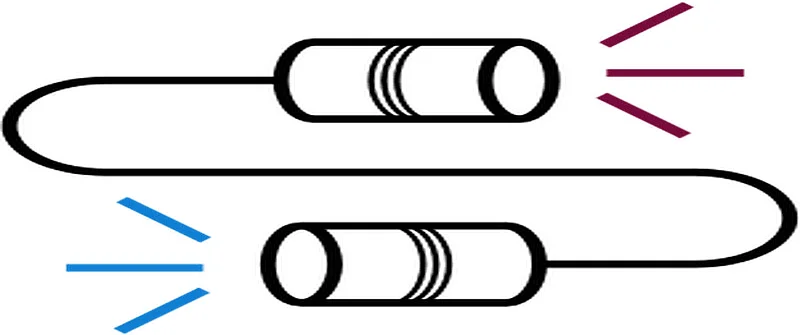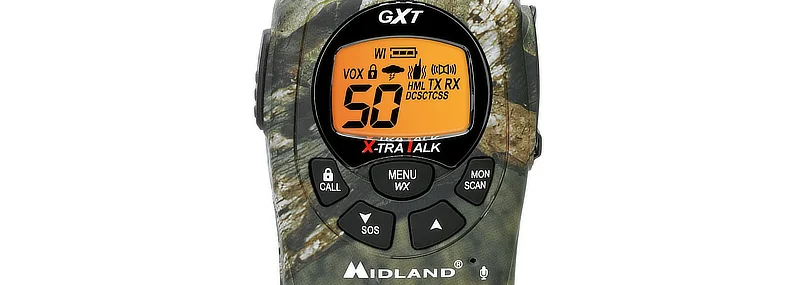2-Way Radio Communication Etiquette and Protocols

I want to point out some good radio communication etiquette procedures and basic 2-way radio protocols to help the beginner with the use of these radios or ‘walkie talkies’.
Get to know the language protocol of radio communication. Clarity, simplicity, and shortness are the basic rules for radio communication.
In a world ruled by mobile devices, it’s amazing that two-way radios have stood the test of time more than 80 years since they were invented. They remain a necessary piece of equipment for first responders, security personnel, around the farm and property, and many types of business.
Here are some radio protocol/etiquette tips for using a two-way radio so you’ll always present yourself professionally and ensure good communication.

Most well-reviewed GMRS/FRS handheld 2-way radio
Midland GXT series
(view on amzn)
Basic Radio Communication Protocol & Etiquette
- When using a two-way radio, you cannot speak and listen at the same time, as you can with a phone.
- Do not interrupt if you hear other people talking. If you hear other people talking, wait until their conversation is finished unless it is an emergency.
- Do not respond if you aren’t sure the call is for you. Wait until you hear your call sign to respond.
- Never transmit sensitive or confidential information (unless you are certain your conversations are secured with the proper level of encryption, assume your conversations can be heard by others).
- Perform radio checks to ensure your radio is in good working condition or is within range to transmit/receive signals.
- Memorize call signs of persons and radio stations you communicate with regularly.
- Keep the volume high enough to be able to hear calls.
- In radio communication, you are not called by your name. Everybody has their own unique call sign.
- Think before you speak.
- Decide what you will say before you say it, and to whom it is meant.
- Make your conversations as concise, precise, and clear as possible.
- Avoid long and complicated sentences. If your message is long, divide it into separate shorter messages.
- Do not use abbreviations unless they are well understood by your group.
Clarity
Your voice should be clear. Speak a little slower than normal. Speak in a normal tone, do not shout.
Simplicity
Keep your message simple enough for intended listeners to understand.
Brevity
Be precise and to the point.
Security
Do not transmit confidential information on a radio unless you know the proper security technology is in place. Remember, frequencies are shared, you do not have exclusive use of the frequency.
Protocol of Making a Call on a 2-Way Radio
Follow these easy steps to make a call.
- First, listen to ensure the channel is clear for you.
- Press the PTT (Push-To-Talk) button.
- After 2 seconds:
- Say “recipient’s call sign”
- Followed by “THIS IS” and “your call sign”
- Once the person replies, convey your message.
Radio Communication User’s Language
Go Ahead – Resume transmission. You are ready to receive the transmission.
Say Again – Re-transmit your message
Stand-by – Transmission has been acknowledged, but I am unable to respond immediately.
Roger or Ten Four – Message received and understood.
Affirmative – Yes – Avoid yup, nope, etc.
Negative – Same as “No”.
Over – This is the end of my transmission to you and a response is necessary.
Out – Communication is over and no answer is required or expected. The channel is available for others.
Radio Check – What is my signal strength? Can you hear me?
Read you loud & clear – Response to “Radio Check”. This means the transmission signal is good.
Come in – You are asking the other party to acknowledge they hear you.
Copy – You understand what was said.
Wilco – Means “I will comply”.
Example Call
5-9 is your call sign
6-2 is the recipient call sign
You (5-9) “Six-Two this is Five-Nine, Come in, Over”
Recipient (6-2) “Five-Nine this is Six-Two, Go Ahead, Over”
You (5-9) “When you’re getting the eggs, let me know if the chickens need more water, Over”
Recipient (6-2) “Roger, Over”
You (5-9) “Are you going to do it soon?”
Recipient (6-2) “Affirmative, Over”
You (5-9) “Okay great. Five-Nine Out”
TIP: Unless you’re a licensed ham radio operator (or any operator with a specific call sign), rather than using your names, consider establishing your own unique call sign identifiers for frequency bands where licensing is not necessarily required.
It may seem strange at first to begin and end your transmission with call signs (eg “Five-Nine”, “Six-Two”, or whatever…), however this identifies who the message is intended for, because others may be on the same frequency. It brings clarity to the conversation over the airwaves.
TIP: An MSB commentator said, “You never say Roger AND Wilco in the same reply. Wilco means Will Comply, Roger is already understood. Saying WILCO implies that you understand (ROGER is “built-in”). I hate to be the “radio police” but if you knew how many times I got slapped in the back of the head as a Private learning to properly talk on the radio, you’d understand.”
Radio Communication Tips
It’s good radio communication etiquette to leave a second or two between “hand-offs” to give others a chance to break in.
It is always best to speak in short simple phrases on the radio and toss the conversation back and forth with the word “OVER.”
Don’t speak immediately when you press the PTT (push to talk), especially with digital radios which among all their benefits have slightly longer delay. Wait 2-3 seconds.
If you speak as soon as you press the PTT button, it can chop off your first syllable or word, making it hard to understand. If that word doesn’t make it, you will just have to repeat it and run down your batteries faster.
Standard NATO Alphabet
International phonetics is used for the alphabet to spell out letters over the radio.
When you need to spell out something over a 2-way radio, don’t use letters as many of them sound alike. Spell them out using what’s known as the NATO (North Atlantic Treaty Organization) phonetic alphabet instead. This system uses a word that corresponds with every letter of the English alphabet so there’s no confusion.
| Symbol | Code Word | Morse Code |
| A | Alfa/Alpha | ● ▬ |
| B | Bravo | ▬ ● ● ● |
| C | Charlie | ▬ ● ▬ ● |
| D | Delta | ▬ ● ● |
| E | Echo | .● |
| F | Foxtrot | ● ● ▬ ● |
| G | Golf | ▬ ▬ ● |
| H | Hotel | ● ● ● ● |
| I | India | ● ● |
| J | Juliett | ● ▬ ▬ ▬ |
| K | Kilo | ▬ ● ▬ |
| L | Lima | ● ▬ ● ● |
| M | Mike | ▬ ▬ |
| N | November | ▬ ● |
| O | Oscar | ▬ ▬ ▬ |
| P | Papa | ● ▬ ▬ ● |
| Q | Quebec | ▬ ▬ ● ▬ |
| R | Romeo | ● ▬ ● |
| S | Sierra | ● ● ● |
| T | Tango | ▬ |
| U | Uniform | ● ● ▬ |
| V | Victor | ● ● ● ▬ |
| W | Whiskey | ● ▬ ▬ |
| X | X-ray | ▬ ● ● ▬ |
| Y | Yankee | ▬ ● ▬ ▬ |
| Z | Zulu | ▬ ▬ ● ● |
[ Read: Best BaoFeng Antenna Upgrade for Ham Radio or GMRS, FRS, MURS Bands ]
[ Read: Chirp Software for Programming a Baofeng Radio – How to use ]
